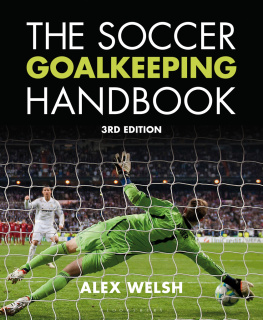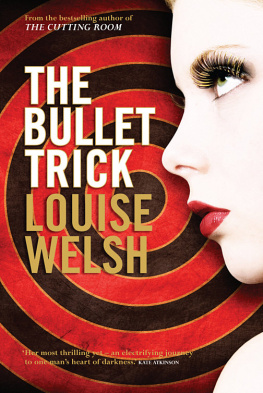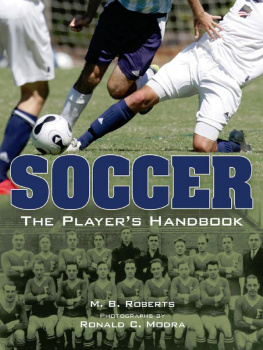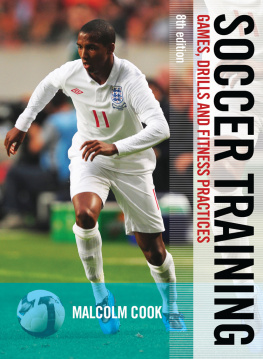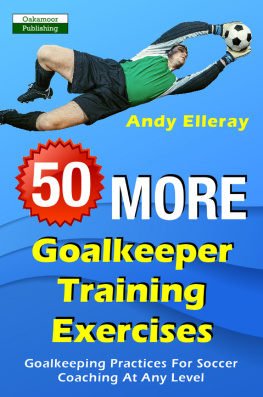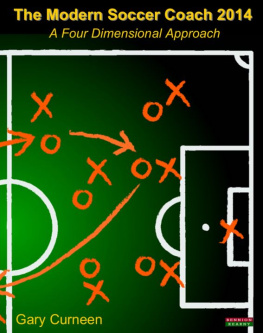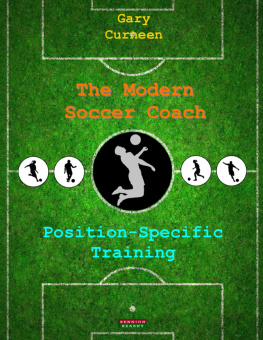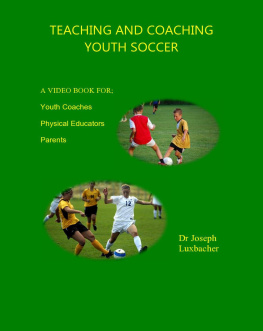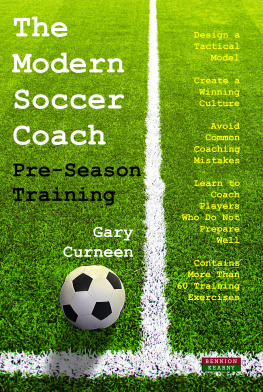CONTENTS
PREFACE TO THE THIRD EDITION
I am very pleased to have the opportunity through this third edition to update the ideas and practices in this book. As the demands of the game are constantly changing it is vital that coaches ensure their work with players is relevant and keeps pace with current match requirements. After all, if coaching does not lead to improved match performance it is pointless.
In producing this book I would like to thank my good friends Pauline Cope (Charlton Athletic Ladies FC), Paul Heald (Wimbledon FC), Stuart Taylor (Arsenal FC), Emma Byrne (Arsenal Ladies FC) and Lee Butcher (Welling United FC) for their excellent contribution. The photo shoot was great fun and the standard of goalkeeping demonstrated in the impromptu training session at the end was breathtaking. I have coached all of them at various stages of their careers and they are all tremendous goalkeepers. I am grateful also to James Dalton (England futsal team) for his guidance on futsal goalkeeping techniques. I am also indebted to the many specialist coaches I have befriended over the years, in particular Perry Suckling for his ideas, generosity and integrity. My biggest vote of thanks goes to Bob Wilson who has exerted the greatest influence on my coaching career. As one of the worlds leading authorities on the art of goalkeeping, Bob has been a tremendous source of knowledge and inspiration and taught me to always accentuate the positive. Thanks also to all the goalkeepers I have coached over the years. Each of them has presented a new challenge and helped me to improve my coaching effectiveness.
Finally, I am extremely grateful to my wife Maria for not only typing the original manuscript and curbing my verbosity but also for her continued support of my coaching work.
FOREWORD
The Soccer Goalkeeping Handbook is one of the best ever books written about the art of goalkeeping. It is certainly the most comprehensive. Whether you hold a burning ambition to play between the sticks, have a desire to coach and improve aspiring talent, or are simply curious about this most complex position, this is a manual that will broaden your knowledge, surprise you and best of all inspire you. Having worked with Alex Welsh over many years, I am flattered to constantly hear myself talking within these pages. We have always shared ideas, thoughts and beliefs. Without sounding conceited, we believe our way should be the benchmark adopted by national governing bodies.
The Soccer Goalkeeping Handbook is based on the best coaching principles and that is why I am so proud to be associated with it. Read this handbook, read it again, absorb it all and then, as a keeper, go out and improve your game or, as a coach, blend the best of these ideals with the best of you. All you need to know about modern-day goalkeeping is contained within these pages. Simply adapt them to your own style, strengths and personality.
Bob Wilson
Arsenal FC and Scotland
Arsenal FC Head Goalkeeping Coach
Sports Broadcaster
HOW TO USE THIS BOOK
This book is written with the needs of the player, coach and parent in mind. For the player it might be affirmation or clarification on a particular point; for the coach it might be ideas on developing a technical or tactical theme; and for the parent it might be simple guidance. Essentially the book is concerned with improving a goalkeepers match performance and helping the reader to become a more effective keeper.
The book is divided into three main parts. identifies the key elements of goalkeeping success, which in turn provide a focus for the various practices later in the book. It also explores what makes a successful coach and offers advice on planning individual sessions and programmes as well as developing the keepers physical, mental, technical and social strengths. The chapter on preparing to play and train highlights the importance of being mentally and physically ready for optimum performance. The final chapter in this section describes the fundamentals of goalkeeping emphasising that a mastery of the basics is essential for later success.
provides a range of progressive practices covering the five goalkeeping roles of shot stopping, fielding crosses, dealing with through balls, distribution and organising the defence. Each role is broken down into individual themes which reflect situations that the keeper might encounter during a game. Each theme has a number of realistic and relevant practices attached to it; and with every practice there is an explanation of the assessment, decision and technique involved accompanied by key coaching points. Based on the goalkeepers needs, the coach can then select those practices that are most appropriate. Where applicable, a description of common faults that the coach might encounter when covering a particular theme is provided.
provides tips on goalkeeping in futsal and 5-a-side formats. It also covers physical conditioning for the goalkeeper by providing exercises aimed at improving strength, speed, mobility and agility. Finally the book concludes with the 10 Golden Rules of Goalkeeping.
INTRODUCTION
Contrary to the popular theory, goalkeepers are not mad, they are just a breed apart.
Without doubt, the goalkeeper is the most important position in the soccer team and is the only position stipulated in the laws of the game. Nearly every senior club now has a qualified specialist goalkeeping coach. The performance of the goalkeeper can make or break a team, and it is no coincidence that the most successful clubs have the best keepers. The mad label reflects the individual nature of the job and the lengths to which the keeper will go to protect his goal. Most of the goalkeepers I have met place a clean sheet before personal safety and, therefore, those who do not share the obsession are driven to question their sanity.
This common purpose has led to the development of a genuine camaraderie between goalkeepers. It is often said that they are the keenest of rivals but the best of friends, and this is why people often refer to the goalkeepers union when keepers stick up for each other. After a match goalkeepers often get together to chat about aspects of their craft in a way that outfield players do not.
WHAT MAKES A TOP GOALKEEPER?
Soccer is a team game until the goalkeeper makes a mistake and then it becomes an individual sport.
While a striker will be measured by the positive things he does, a goalkeeper will be judged on the mistakes he makes and this is why the position of goalkeeper is the most pressurised on the field and often the loneliest. All players will make errors, but the keepers usually result in a goal conceded. Once he manages to keep his mistakes to a minimum and prove his reliability, his work will be measured by the important saves he makes. Good goalkeepers put their mistakes behind them and learn from the experience. One mistake does not make a bad goalkeeper, or one save a good goalkeeper.

